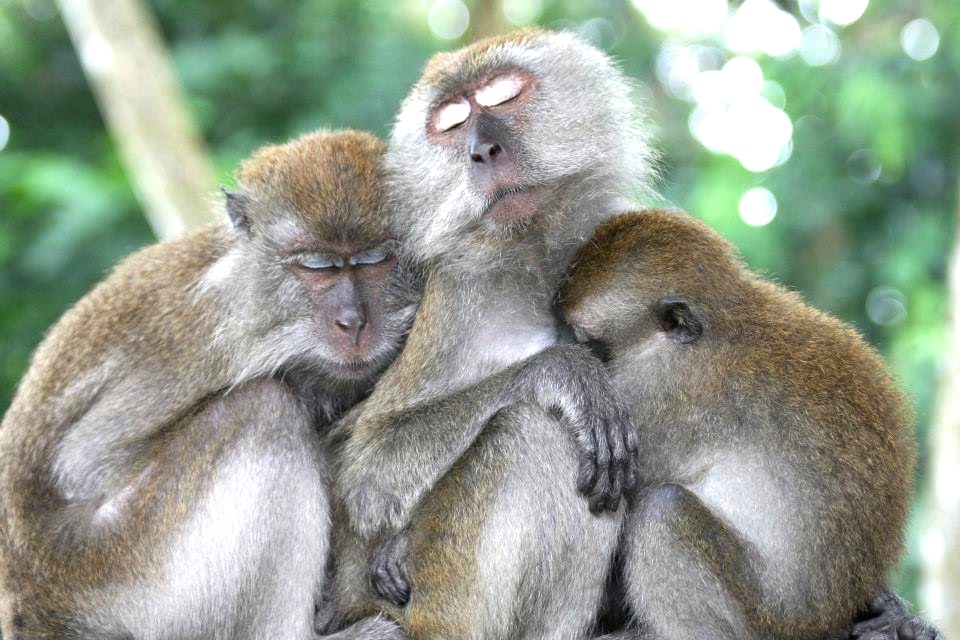
Table of Contents
Two adult females macaques and a juvenile cuddling together. Photo by Amanda Tan, used with permission.
1. Introduction
The long-tailed macaque, also known as the crab-eating macaque, is a native species in Singapore. Like what its name suggest, the animal can be easily identified by its long tail. Commonly encountered in parks, reserves and occasionally residential estates, the long-tailed macaque is not unfamiliar to most of us. While many native species were lost due to urbanisation and habitat destruction, the highly adaptable long-tailed macaque continue to exist in our landscape. The sight of these wild animals jumping between trees, hanging from the trees with their long tail and grooming each other is a beautiful sight to behold. Not forgetting the little ones that love chasing and wrestling with one another, that makes our neighbourhood even livelier.
Don't stop here, read on to find out more about these lovely critters!
Etymology
The generic epithet Macaca originates from the Portuguese word macaco, derived from makaku. Makaku is a Fiot (West African language) word, and kaku means monkey in Fiot. The specific epithet fascicularis means a small band or stripe in Latin. The epithets were given by Sir Thomas Raffles, who did not explain the use of terms [1].2. Description
The head and body of an adult long-tailed macaque measure to 45cm, with tail up to 56cm [2]. It has a silky, golden brown coat which becomes pale grey to whitish below [2]. The face is brownish to pinkish, with distinct eyelids above the eyes, sometimes also observed faintly below the eyes [2]. You might also observe an irregular tuft of hairs behind the ears [3]. These features vary among individuals, and are often used by researchers to distinguish different troops, and even members of the same troop.
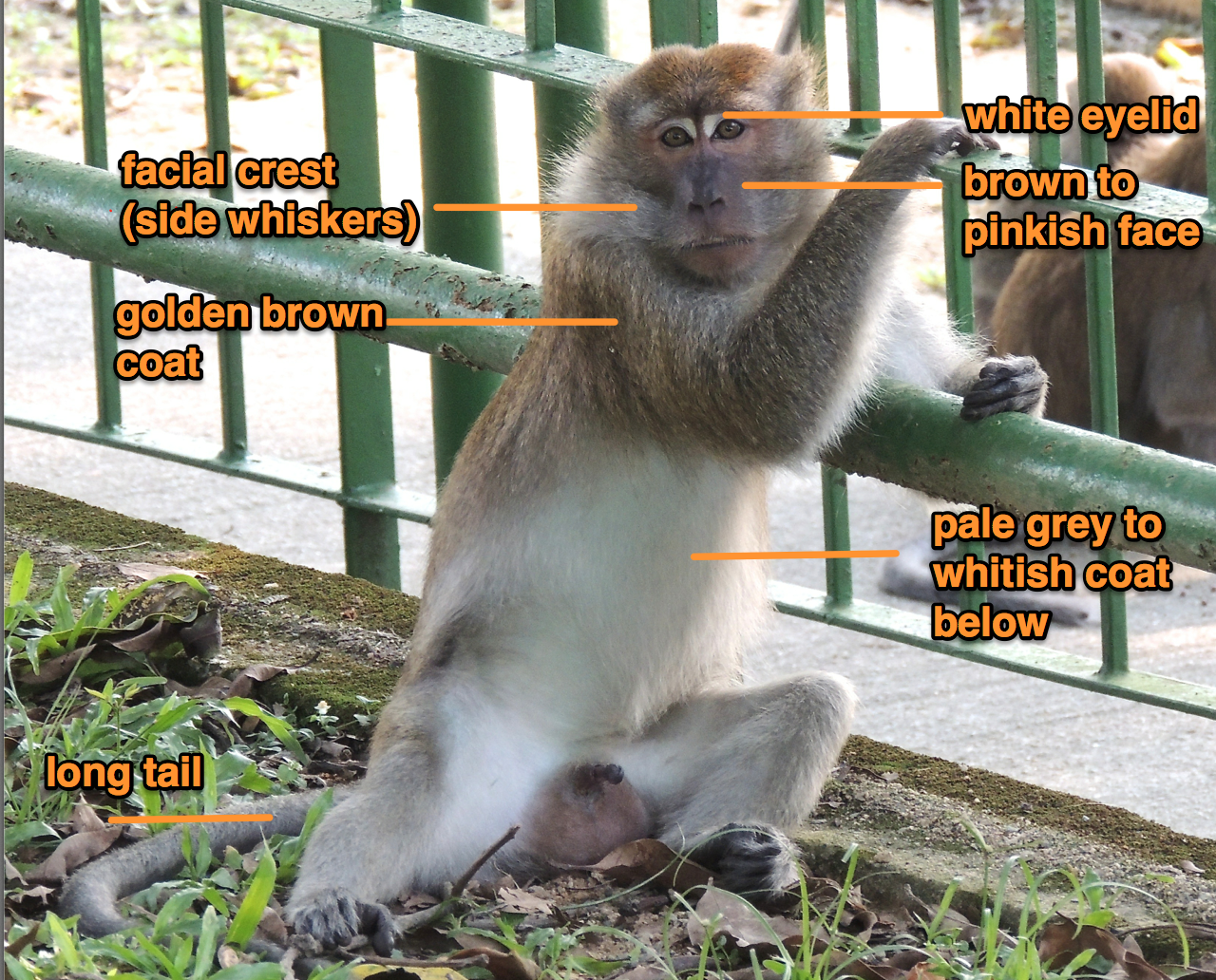
Unlike adults, infants are born with black fur and pinkish facial skin with minimal hair, with the fur slowly changing to golden brown when they are around 2 to 3 months old [3]. Interestingly, the transition from black to brown coat begins with the limbs, then the body and finally, the crown [3].
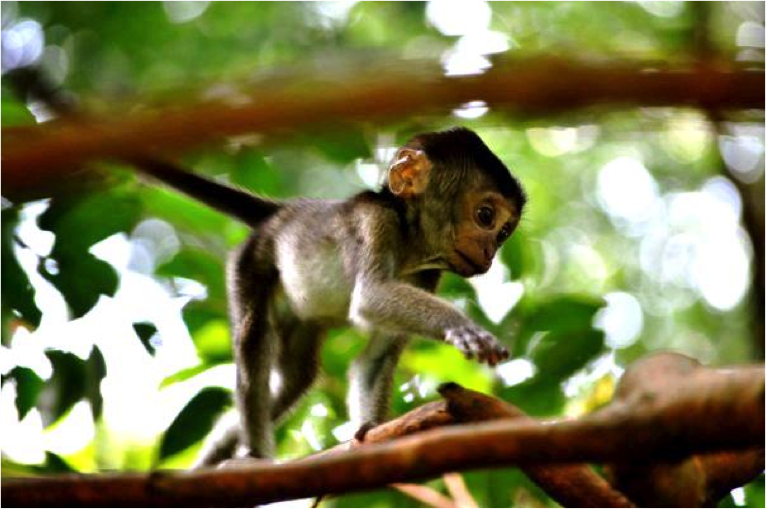
3. Biology
Habitat Preference
Being a forest edge species, long-tailed macaques inhabit the edges of diverse habitat types such as mangroves, swamp, riverine and secondary forests [4, 5, 6]. Their strong adaptability to disturbed habitats has allowed them to successfully thrive in the human modified landscape such as Singapore [7, 8].Diet
Long-tailed macaques are primarily frugivorous, but can become an opportunistic omnivore when fruit availability is limited [9]. While their diet consists mainly of fruits, they also feed on flowers, leaves, stems, insects and human food.When human food is available, it is often preferred over natural food as it is an excellent source of energy, easily digestible and accessible. In Singapore, at least 50% of our long-tailed macaques fed on human food sources, probably due to proximity to human settlements [10]. Therefore, open food sources in settlements can attract macaques to visit, and should be avoided.
Other than that, food can also be directly obtained from humans who deliberately feed them. It is however, important to note that, such actions are not desirable as it encourages macaques to approach humans for food, fuelling human-macaque conflict (Read more at Section 4). Furthermore, these unnatural foods cause health problems in them. Hence, please do NOT feed them.
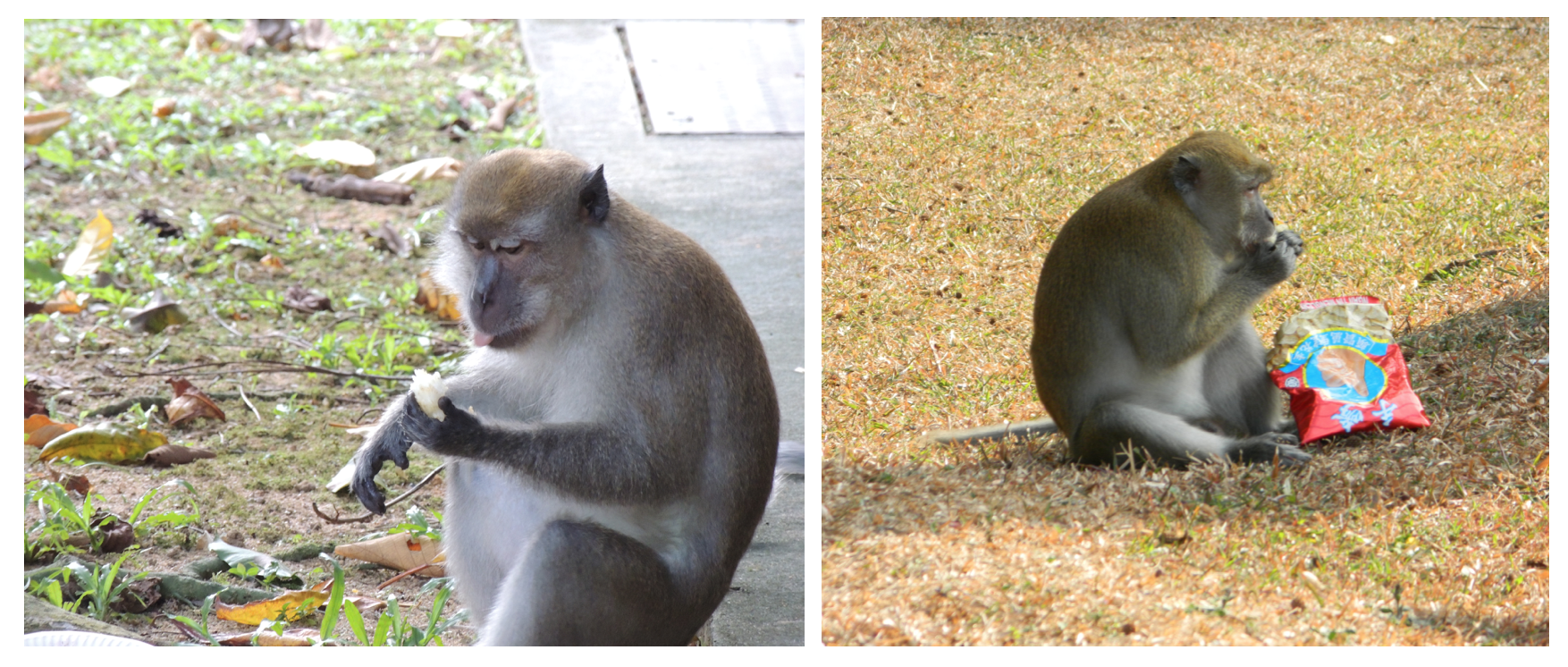
Activity Pattern
Being diurnal animals, long-tailed macaques are active from dawn to dusk. Here’s a typical day for macaques [10, 11, 12, 13]:1) At dawn, they move out of their sleeping sites to look for food.
2) Around noon, macaques rest and sometimes take a little nap on branches of trees or under trees to avoid the heat. When it gets a little too hot, they like to cool themselves down in a nearby pool of water (And yes, they can swim too!).
Photo by Lai Chui Ting, used with permission.
Long-tailed macaques (Crab-eating macaques) are excellent swimmers!
3) They would then feed again during the second feeding peak in the late afternoon.
4) Approaching dusk, the macaques were also observed to engage in play, grooming and inactivity, before heading back to their sleeping sites. These behaviours can occur throughout the day, but more happen more frequently at the end of their day.
5) When the Sun sets, most of them would be at or around their sleeping sites, slowing moving up to the tree and finding their positions. Some of them prefer to cuddle and sleep together, while some prefer to enjoy the space to themselves alone. Macaques have not just one but a few sleeping sites, and the leader of the troop gets to decide where the troop sleeps for the day!
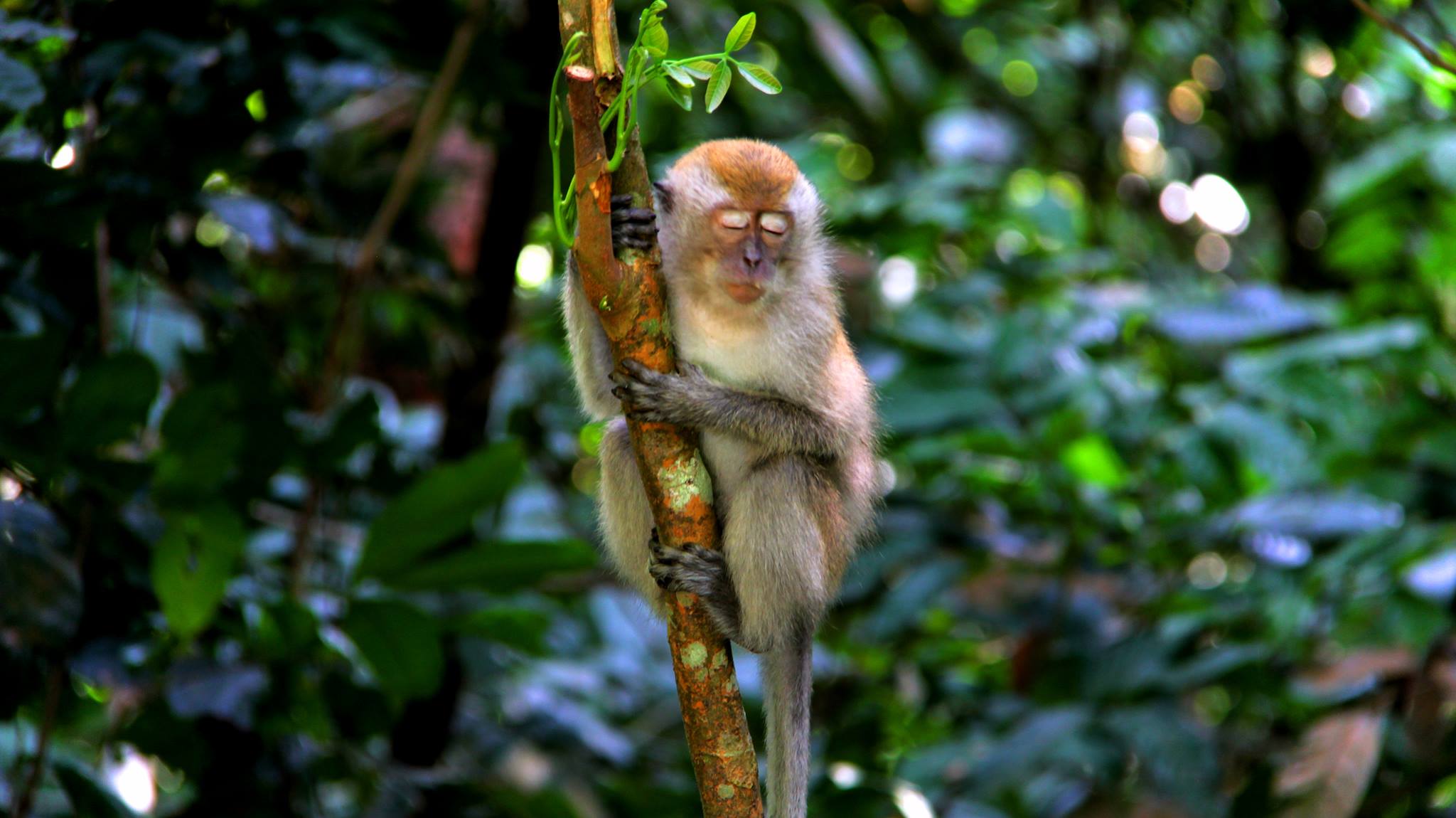
Social Organization
A healthy long-tailed macaque troop consists of 15-35 individuals. Each troop consists of multi males and multi females [14, 15, 16]. Within the troop, they are organised based on social hierarchy or dominance ranks. High ranking individuals usually have greater access to food and protection from predation, as compared to lower ranking individuals. The highest ranking male and female are often known as alpha male and alpha female respectively.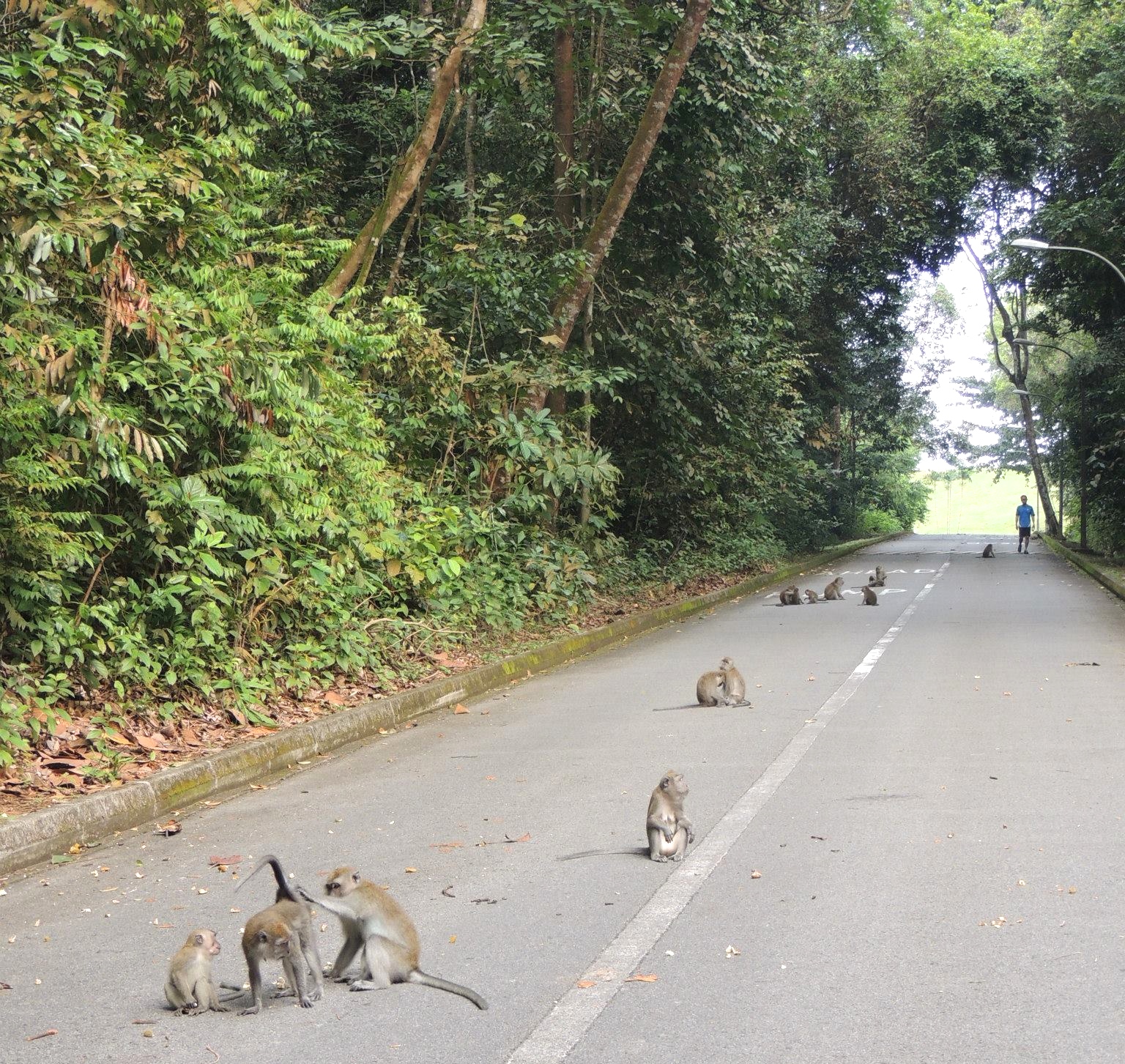
The social ranks of macaques are inherited through the matrilineal lineage [14]. This means that females usually inherit the ranks from their mothers. If the mother is a high ranking individual within the troop, her daughters would be too. Among the siblings, their dominance depend on the birth order [17]. Interestingly, younger females are usually higher in rank than their elder sisters [17].
On the other hand, males usually leave the troop to join another troop and negotiate their rank within the new troop [10]. This is one reason why you sometimes see a lone macaque wandering around in the urban areas. What should you do when you see a lone macaque? Find out more here.
Mating System
Long-tailed macaques have a polygamy and polyandry mating system in the macaques [14]. This means that each male and female have more than one mating partners. Males usually mate within high ranking females to maintain their social ranks while females mate with any available males when fertile.4. Relationship with Humans
Human-Macaque Conflict
Increasing proximity of human settlements to the forest has led to a closer interface, as well as greater opportunities for interaction between humans and macaques. When interactions between humans and macaques negatively impact each other, human-macaque conflict happens [7]. Human-macaque conflict for various species of macaques has been reported for barbary macaques in Gibraltar, formosan rock macaques in Taiwan and long-tailed macaques in Hong Kong as well as Singapore [12, 18, 19].Macaques can negatively impact humans in the form of raiding crops, houses and refuse sites for food, when accessible [20, 12, 21]. When humans behave inappropriately towards macaques, macaques can react aggressively to defend themselves, which may lead to distress or harm for people. Such actions arises from the lack of understanding of humans towards macaques, or wild animals in general.
Humans also impact macaques negatively. In the shared space of humans and macaques, wild macaques can become used to the presence of humans. Feeding by humans causes them to associate humans with food. As macaques learn to approach humans, it may lead to aggression, contact and often, conflict [8, 13]. Gradually, they are recognised as nuisance, and often, measures such as trapping and culling are implemented. These measures directly decimate their population and destabilises the troop structure.
So, how should we behave around macaques? Continue reading to find out more!
Facial Expressions and Body Languages
Like any other primates, macaques use facial expressions and body languages to communicate their emotions to recipients. However, this is often misinterpreted by humans, which can result in unnecessary fear and resent towards the animals. Here’s a guide to help you understand them and know how to behave around them [22]!When macaques are relaxed, they maintain an impassive face and avoid eye-contact. Sometimes, their furrowed brows (especially females) might make them look angry or unhappy, but usually not the case. When a macaque is comfortable around you, it may look at you and 'coo' gently, a way of asking to be groomed. However, please do not make contact. Others may stand not their hind legs to beg for food. Please do not feed them and find out why you should not here.
When uncomfortable with your presence, macaques display several types of facial expressions and body language to prompt you to move away. They do not usually make contact with humans, especially aggressively, as it is a big risk for them to take on opponents bigger than them. Hence, attacks do not usually happen unless you have ignored all the other prompts.
Below are some signs that you can look out for in a distressed macaque. Please be nice and back off when you see such signs.
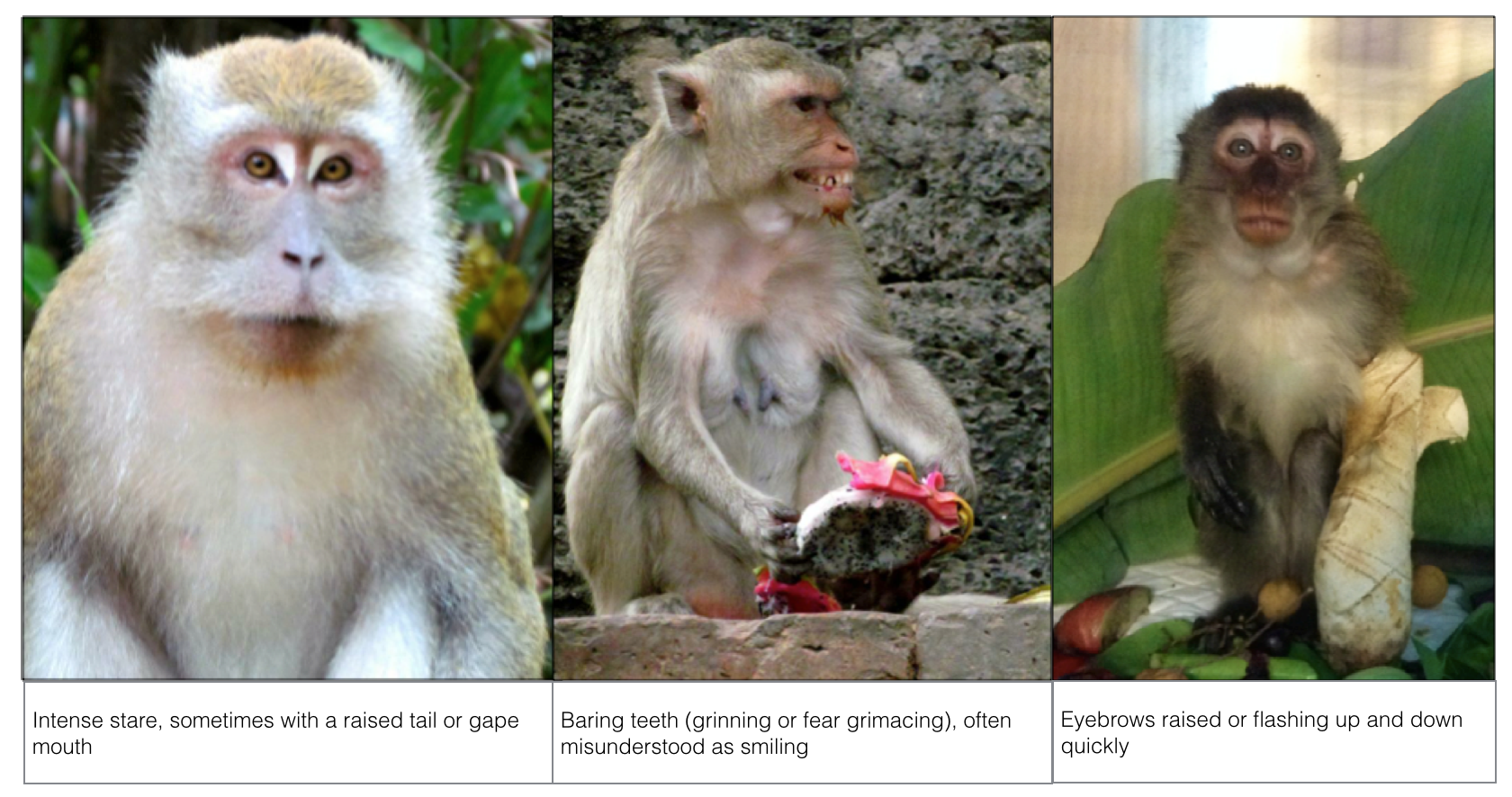
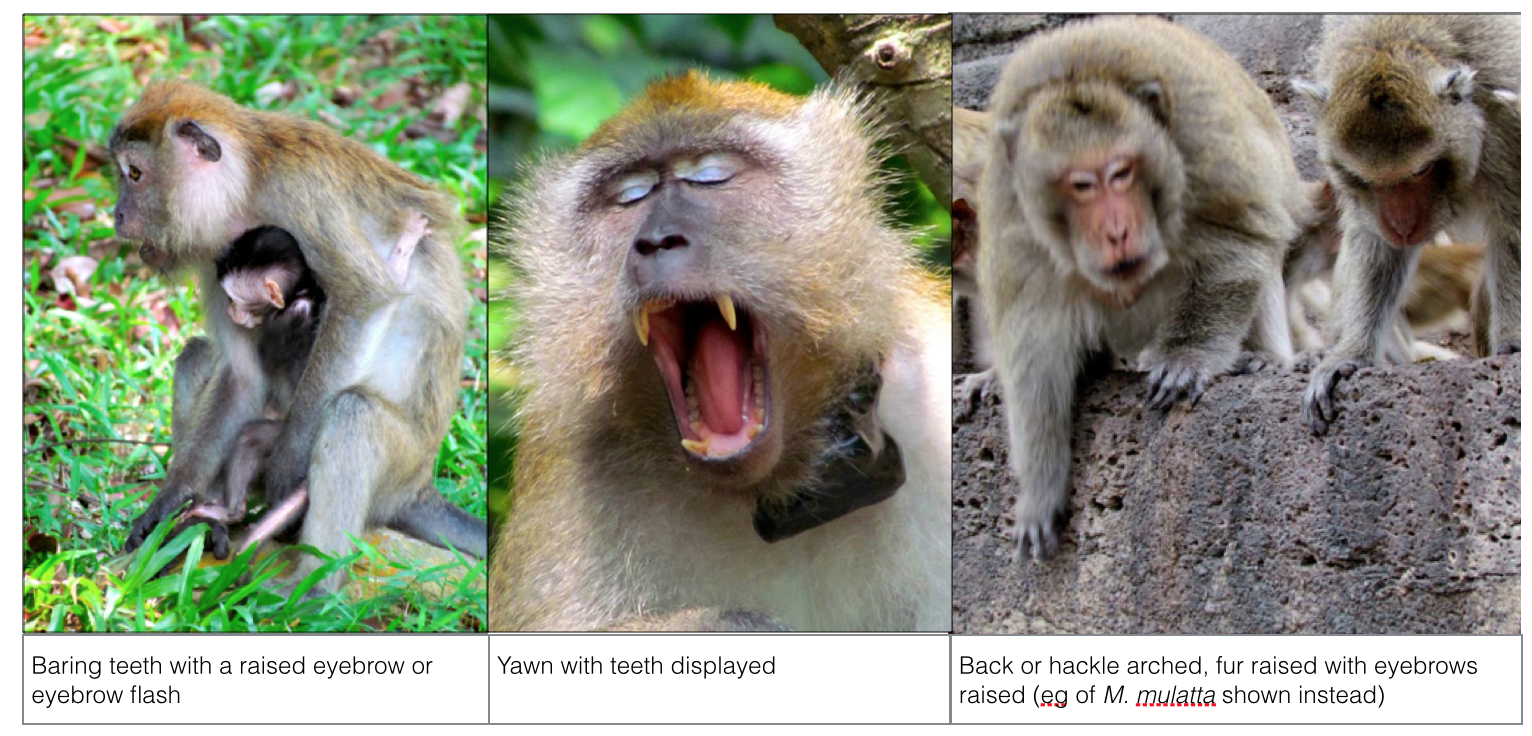
The recipient should move away to give it more space. Photo and content by Amy Klegarth, used with permission.
Living with Monkeys
Information by Amy Klegarth and Sabrina Jabbar [22, 23]:The DOs:
- Proper waste disposal: keep the trash and food out of sight of monkeys.
- Monkey proof waste disposal points.
- Behave appropriately around them. Refer to above section on Facial Expressions and Body Languages.
The DON'Ts:
- Do not scream - macaques will be frightened and upset.
- Do not stare - macaques will take stare as a form of aggression.
- Smile with your lips, not teeth - when you show your teeth, it means that you are either angry or afraid, hence making the macaques upset.
- No wild gesturing - it's seen as aggression by the macaques.
- Do not carry plastic bags - macaques have learnt to associate plastic bags with food, and hence they will go for you.
- No tug-of-war with monkeys - wait for the macaques to lose interest in the item before retrieving it. If you attempt to snatch it from them, the big males may step in to help them.
If you need help with monkey issues, contact the ACRES 24-hour Wildlife Rescue Hotline on 9783-7782.
Lone Macaques
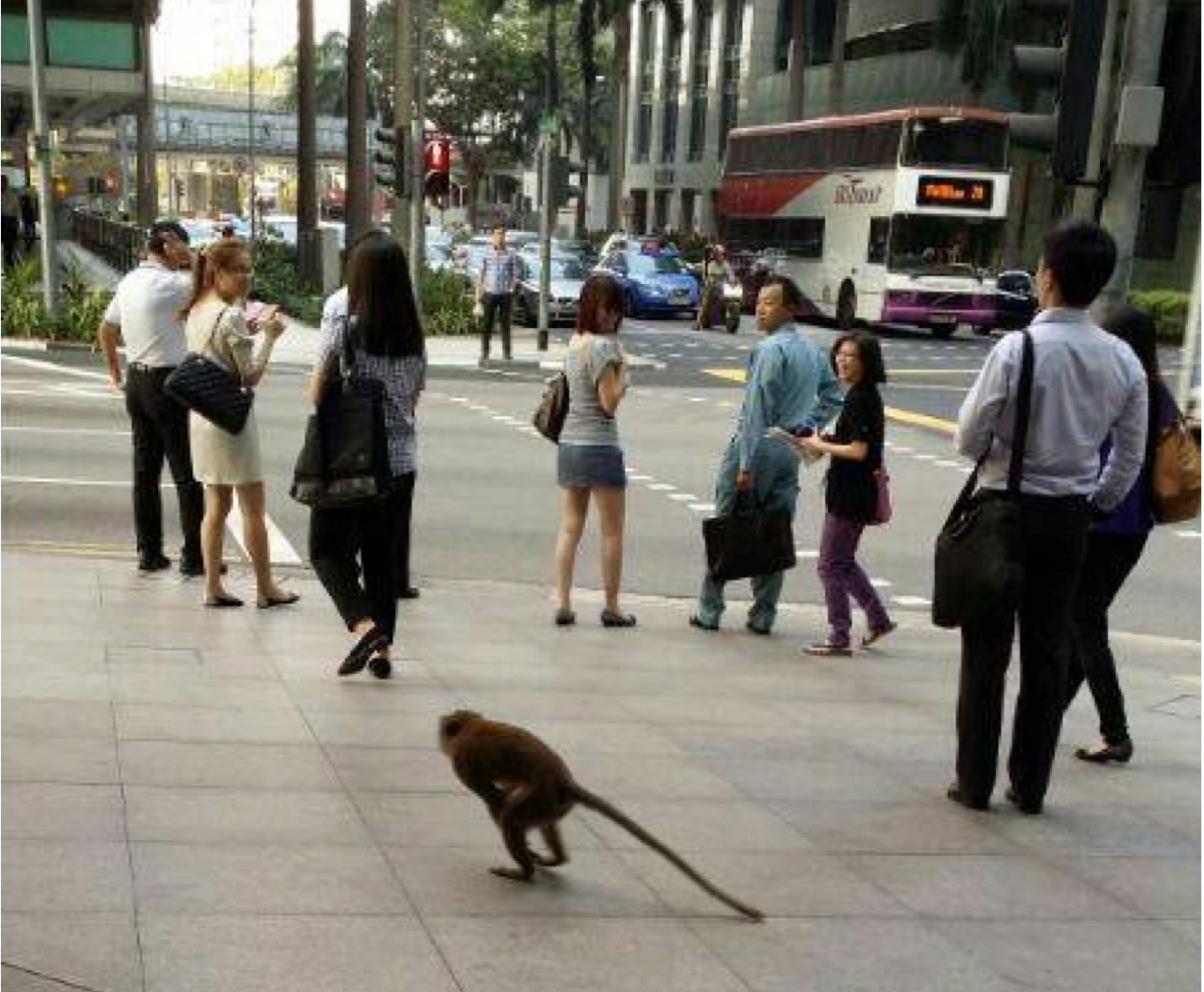
Information by Sabrina Jabbar [23]:
Why do I see lone macaques?
As mention under Social Organization, lone macaques are usually males who leave the troop in search of a new troop. This can also be due to troop segregation and mass culling.
What should I do when I see a lone macaque?
1. Please leave it alone.
2. Ensure proper waste disposal and no food is left around. This will reduce distractions and help the macaque to move on faster.
3. Inform ACRES so that they can monitor the situation.
How long will it take before they leave?
It varies with the individual as well as availability of negative distractions such as food in the area. In certain cases where macaques have high human dependency, they will be less motivated to move on, thus taking a longer time. When the negative distractions are kept away from the macaques, they will eventually leave.
5. Distribution
Global Distribution
The long-tailed macaque is a widely distributed non-human primate species in Southeast Asia, estimated number at 3 million [24, 25]. Its geographic range extends south from southeastern Bangladesh to the Indochinese and Malay Peninsular, Singapore, Philippines and to Timor [7, 26].
Distribution in Singapore
In 1990s to early 2000s, there are less than 1,000 long-tailed macaques in Singapore [27, 28, 29]. In 2008, the number is estimated at 1,218 to 1,454 individuals, with a core population (ca.1,027 individuals) residing within Bukit Timah and Central Catchment Nature Reserves [8].Despite this, there is no clear evidence of a large increase in population size nor density [8]. In fact, the density of long-tailed macaques within the Bukit Timah and Central Catchment Nature Reserves was reported to be lower than of more naturalistic population, that have lesser contact with humans [8]. As long-tailed macaques prefer to stay on the edge of forests or habitats, they are often conspicuous in our landscapes, which can be misleading to people that there is a dense population [8].
6. Threats
Global Threats
Although accorded the conservation status of Least Concern in the IUCN Red List [26], long-tailed macaques face several threats which includes: 1) habitat loss and degradation 2) human-macaque conflict and 3) trapping and trade for pharmaceutical testing, research and development. It was suggested that the conservation status was devalued due to human-macaque conflict in Southeast Asia [30].Habitat loss and degradation is a widespread problem faced by many species worldwide. Often, this also means human settlements become in greater proximity to the forest. This creates more opportunities for macaques, who are edge-dwelling species, to come into contact with humans more frequently. This contributes to rising human-macaque conflict when macaques raid crops or houses in search of food and when humans alter behaviour of macaques through feeding [7, 26].
The largest threat from pharmaceutical trade comes from the Indochinese Region, especially Cambodia, where wild macaques are harvested and transported to China and USA for captive breeding (based on 2003-2004 figures) [26].
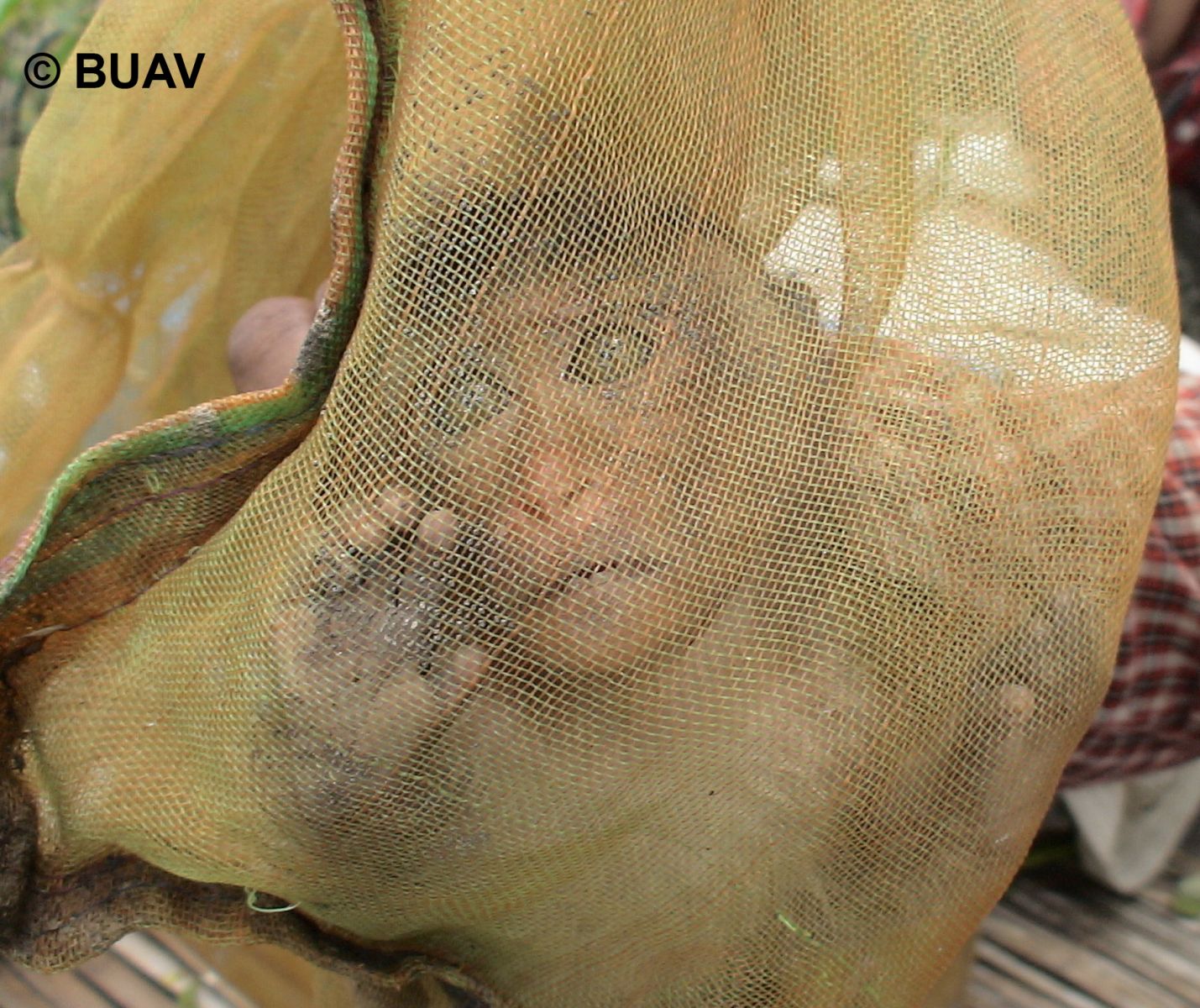
Exploitation of long-tailed macaque in international trade.
Photo by British Union for the Abolition of Vivisection (BUAV).
Threats in Singapore
The long-tailed macaques in Singapore face similar threats, with human-macaque conflict being a particularly pronounced pressure. This includes culling and roadkill.CullingComplaints on nuisance macaques from the public often lead to arbitrary culling of large numbers of macaques by the Agri-Food and Veterinary Authority (AVA). In 2013, 1860 feedbacks on macaques were received by AVA, and 570 monkeys were culled, representing one-third of the population. As of October 2014, about 150 monkeys were culled [27]. Although culling is adopted as the main solution to mitigate human-macaque conflict in Singapore, it is not scientifically proven to be successful or sustainable.
Is there a need to trap and kill monkeys in Singapore?
Does culling mitigates human-macaque conflict in Singapore?
How does AVA carry out its trapping operations?
This informative short video (3-mins) explains further.
Roadkills
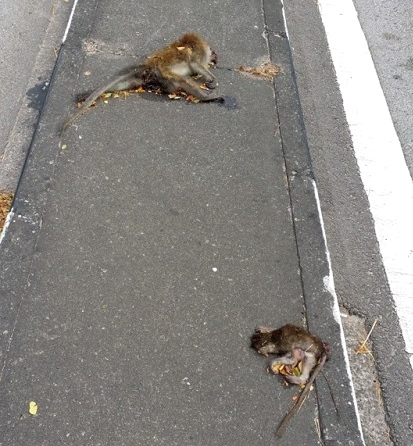
The victims of roadkill - a female macaque and her baby.
Photo by Sabrina Jabbar, story reblogged by Monday Morgue.
Long-tailed macaques often fall victim to roadkills. They move from one point to another through the canopy of trees. However in Singapore, as trees are trimmed to reduce tree falls and accidents, it gets much harder for them to do so. Instead, they attempt to cross the roads. Unfortunately, vehicles driving at high speed along roads and expressways often fail to see them or stop in time to avoid them.
Hence, a note to all drivers: do drive slowly and carefully, and look out for any wild animals crossing the road, especially near the nature reserves.
"Crossing a road may be simple for you, but for them, it is a battle they have to face just to make it out alive" (Sabrina Jabbar, 2014)
7. Taxonomy
Taxonavigation
Ranks are discarded as they do not contain meaningful taxonomic information.The following shows the classification of M. fascicularis [32]. Each taxon displayed is a subset of the taxon above it. For example, 'Primates' is group under 'Mammalia'.
Animalia
Chordata
Mammalia
Primates
Cercopithecidae
Macaca
M. fascicularis
Type Specimen
The type specimen of M. f. fascicularis was not preserved. However, the type specimen was described and documented by Raffles in 1821. It originated from Sumatra, restricted to ‘neighbourhood of Bencoolen [=Bengkulu]” [33].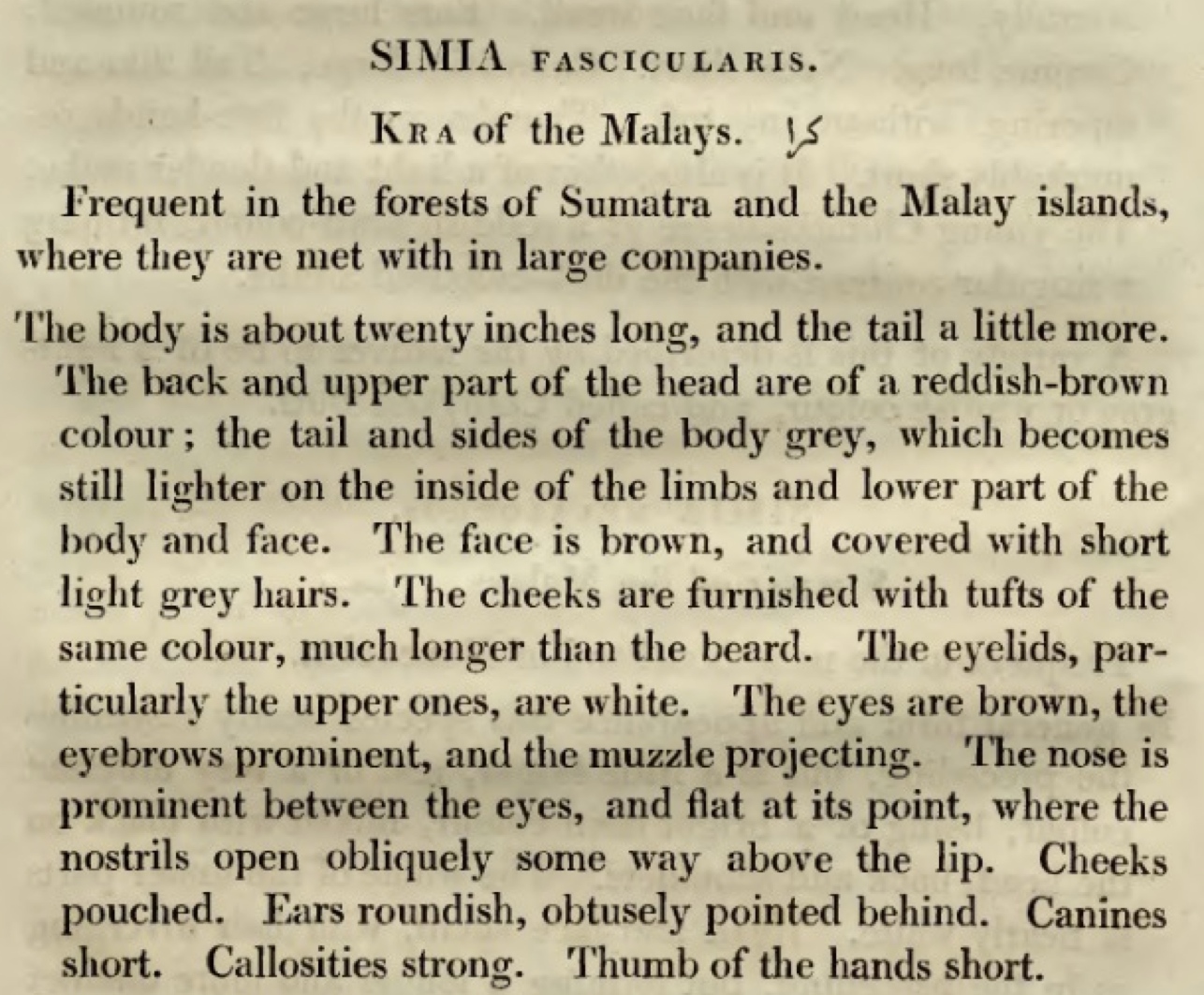
Under under a Creative Commons Attribution-Noncommercial License.
The holotype was likely an adult female. Five specimens were sent by Raffles from Sumatra or Java to two museums in London, three from Sumatra to the museum of Zoological Society of London and, two from either Sumatra or Java to the museum of East India Company. When both museums were disbanded, specimens were transferred to the British Museum of Natural History, London. However, the holotypes were not preserved.
Diagnosis
The long-tailed macaque is most easily identified by its long tail, that is much longer than its head to body length [25]. When using relative tail length as a index value to compare tail length across body sizes, it ranged from 1.163 +/- 0.1555 in adult females to 1.176+/- 0.1337 in adult males [25].Although there is only one species of macaque in Singapore, we can find the its sister species in other parts of Southeast Asia. These are the close relatives of the long-tailed macaques. They belong to the same genus Macaca, but are different species. It is generally accepted that long-tailed macaques have 19 sister species within the group of Macaca [31, 33, 34, 35, 36, 37, 38]. They are M. sylvanus, M. silenus, M. nemestrina, M. tonkeana, M. maura, M. ochreata, M. brunnescens, M. hecki, M. nigrescens, M. nigra, M. mulatta, M. cyclopis, M. fuscata, M. fascicularis, M. arctoides, M. radiate, M. sinica, M. assamensis and M. thibetana.
A notable species is the Japanese macaque (Macaca fuscata). Often known as the Snow monkeys, they are found residing within areas of Japan where snow fall is common. Unlike the long-tailed macaques, their coat colour can vary from grey to yellow brown or brown. Additionally, they are easily differentiated from the long-tailed macaques by their short tail.
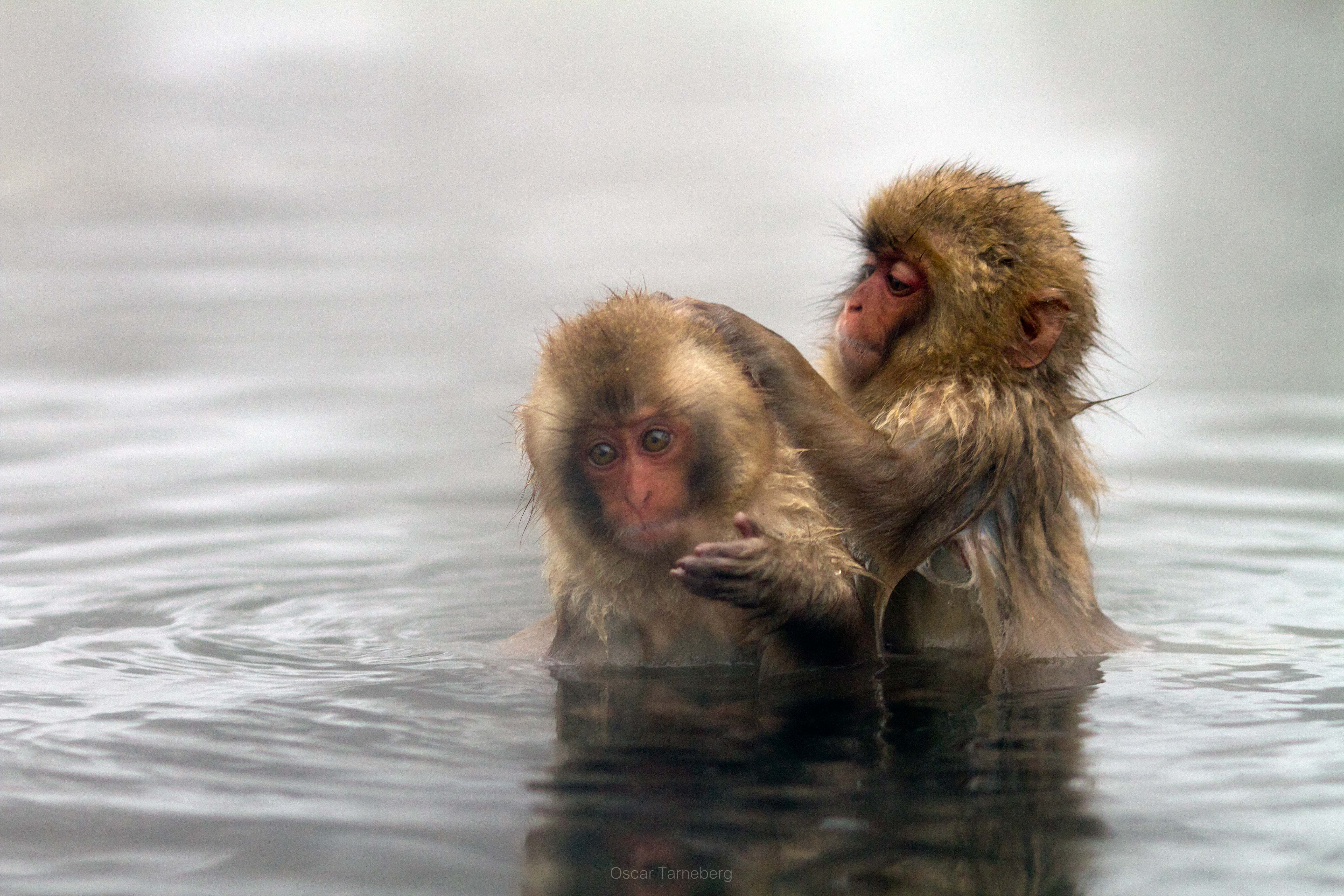
Another example is the Barbary macaque (Macaca sylvanus), the only non-human primate species found in Europe. Its coat varies from grey to yellow to brown. The absence of tail in the Barbary macaque differentiates it from the long-tailed macaque. This is also the reason why it is sometimes known as Barbary ape or Rock ape, although it is not an ape.
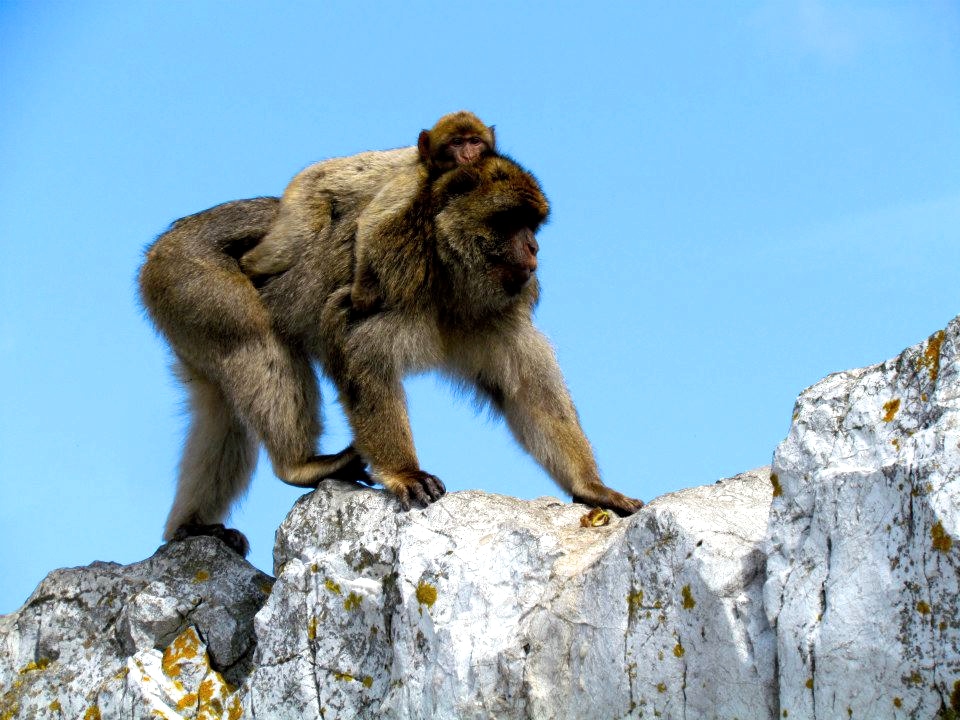
Subspecies
Although being debated, it is generally accepted that there are 10 subspecies of long-tailed macaques [33, 34]. They are distinguished by three main external characters of post-infant stage: 1) colour of the crown, thigh and coat at the back of the body, 2) lengths of head, body and tail and, 3) lateral facial crest (side whiskers) pattern [33].Do you know the differences between the subspecies of M. fascicularis?Here's a brief summary adapted from Fooden (1995) and Brandon-Jones et al, (2004). [33, 34].
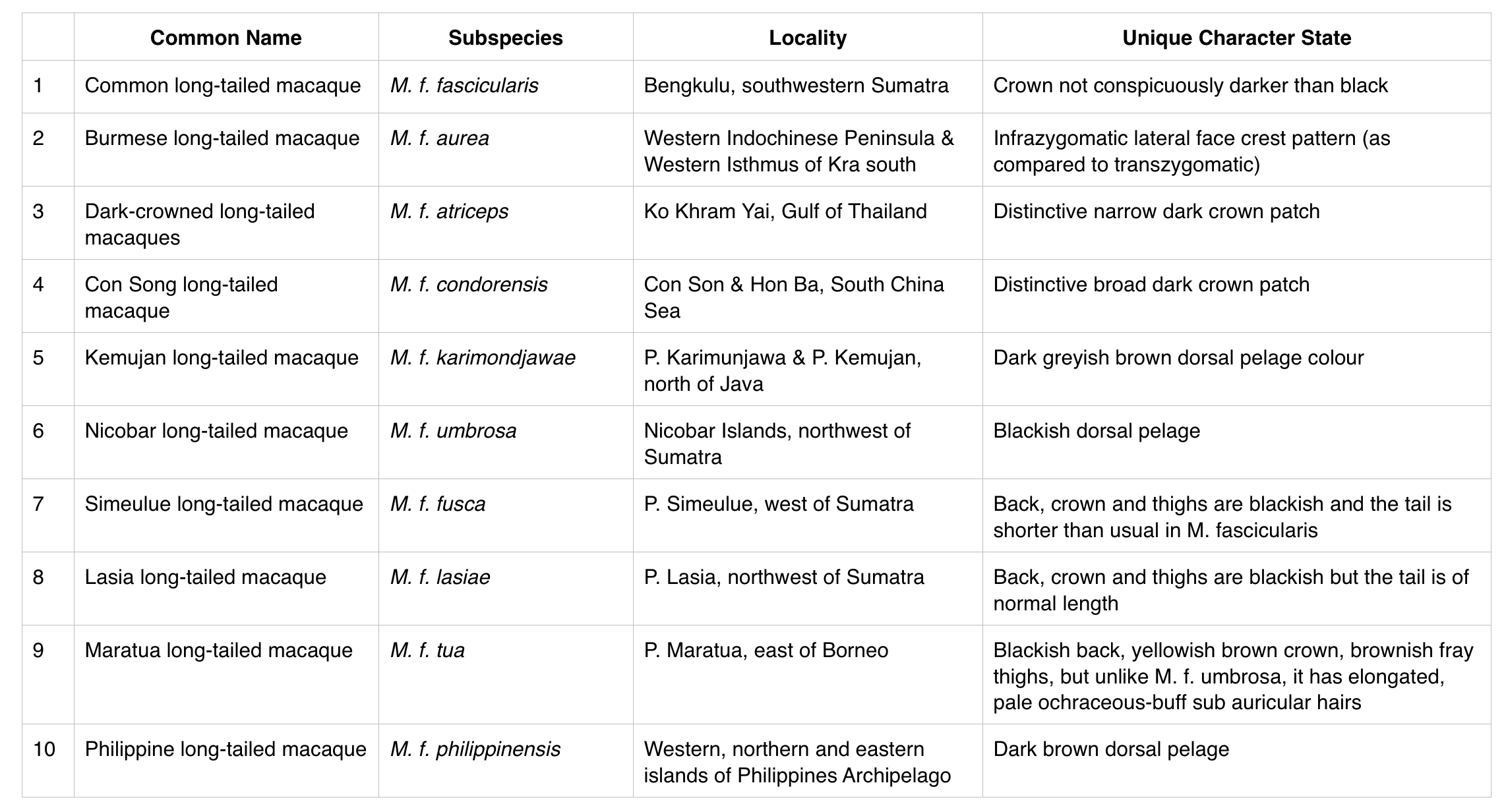
Due to the lack of images from reliable resources, only the Burmese long-tailed macaque (M. f. aurea) is shown below. The image is used with permission, from Amanda Tan, who studies the Burmese long-tailed macaque in Thailand. Some of these populations are known to use stone tools.
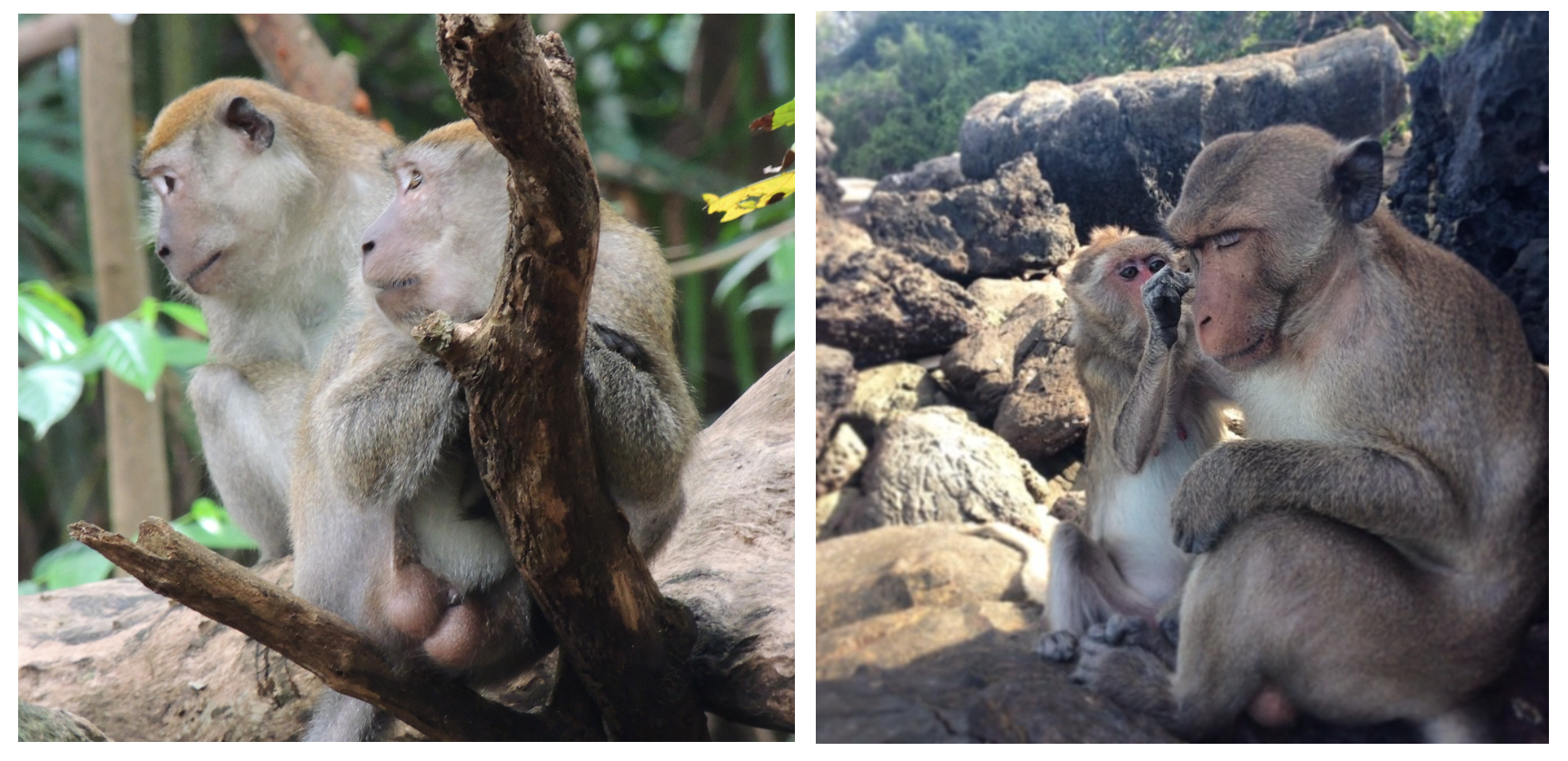
Phylogeny
Until now, the phylogeny of genus Macaca remains debated [33, 34, 40, 41, 42, 43]. Majority of the studies based on morphological and molecular genetic analyses suggested four species groups within genus Macaca. However, the general consensus has only been reached for three groups, which are the silenus, sinica and fascicularis group.Why? Firstly, the number of sister species and species group under the genus Macaca, especially for Asian macaques, are not consistent. Secondly, the phylogenetic position among the Asian species group is still being debated. Lastly, the suggested position of M. arctoides is largely variable across studies [43].
Morphological Analysis
Morphological analysis based on male genitalia morphology suggested the following classification [35]: 1) silenus-sylvanus group: M. sylvanus, M. silenus, M. nemestrina, M. tonkeana, M. maura, M. ochreata, M. brunnescens, M. hecki, M. nigra, M. nigrescens; 2) fascicularis group: M. fascicularis, M. mulatta, M. fuscata, M. cyclopis; 3) sinica group: M. sinica, M. radiata, M. assamensis, M. thibetana and 4) arctoides group: M. arctoides.
However, examination of dentition and cranium by Delson (1980) reclassified M. arctoides under sinica group and removed M. sylvanus from silenus-sylvanus group to form a sister taxon of the other three groups [43]. This conclusion is supported by molecular data [43].
Molecular Analysis
Wide range of characters were used for molecular analysis across studies, including Y-chromosomal DNA [42], mitochondrial DNA [39, 42], autosomal loci [42], nuclear and genetic markers [43, 44]. However, results were not conclusive.
Examples of phylogenetic tree obtained from molecular markers are shown below [42]. Y-chrosomal DNA Tree shows paraphyly among M. fascicularis lineages while mitochondrial DNA Tree shows monophyly among M. fascicularis lineages.
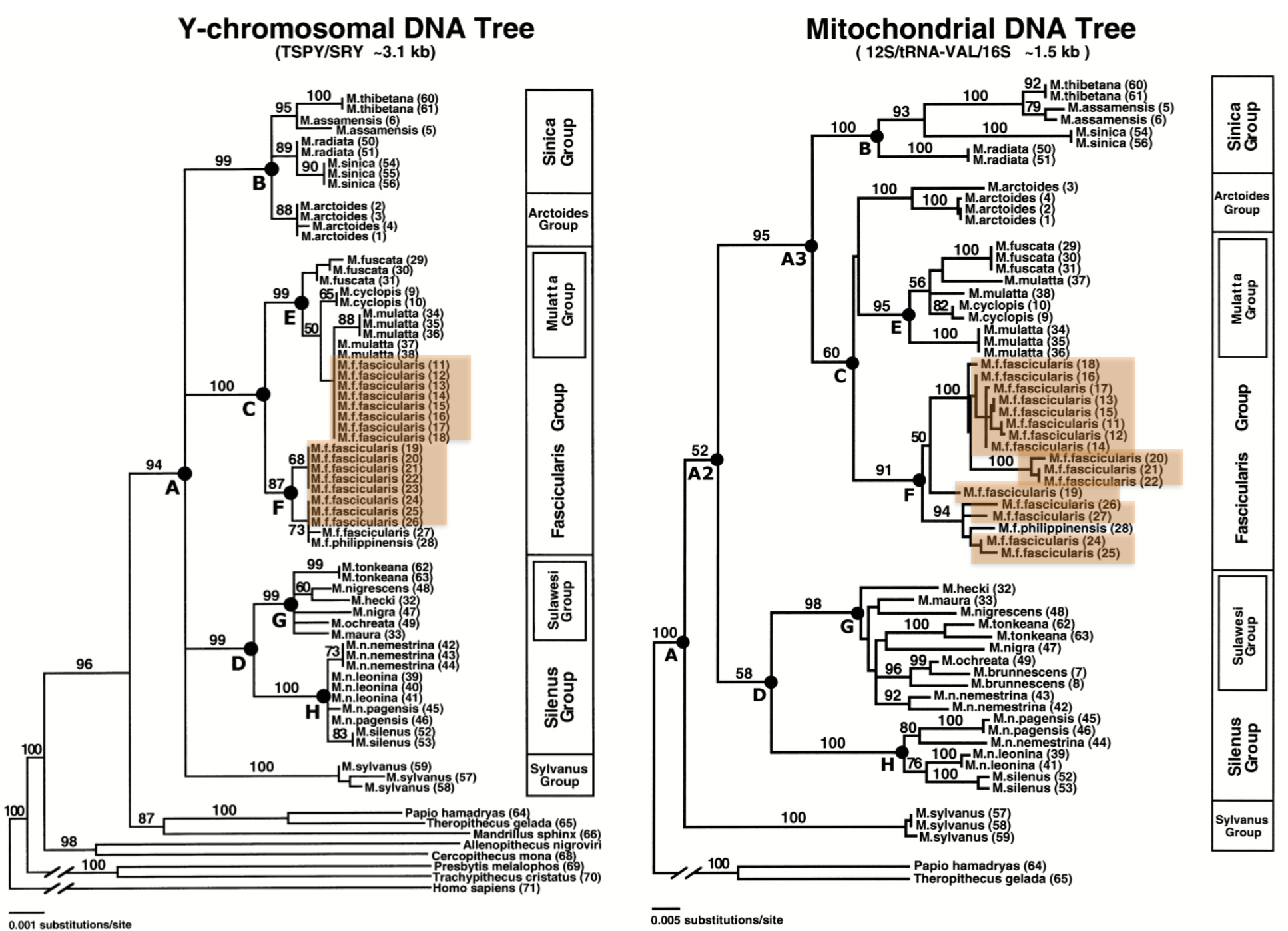
Singapore
Long-tailed macaques in Singapore form a monophyletic group with two sub-populations in Bukit Timah Nature Reserve and Central Catchment Nature Reserve respectively [46]. This was established using neighbour-joining trees and parsimony trees conducted on mitochondrial DNA fragments (Cytb, 12s rRNA, COI, COII and COIII) [45].
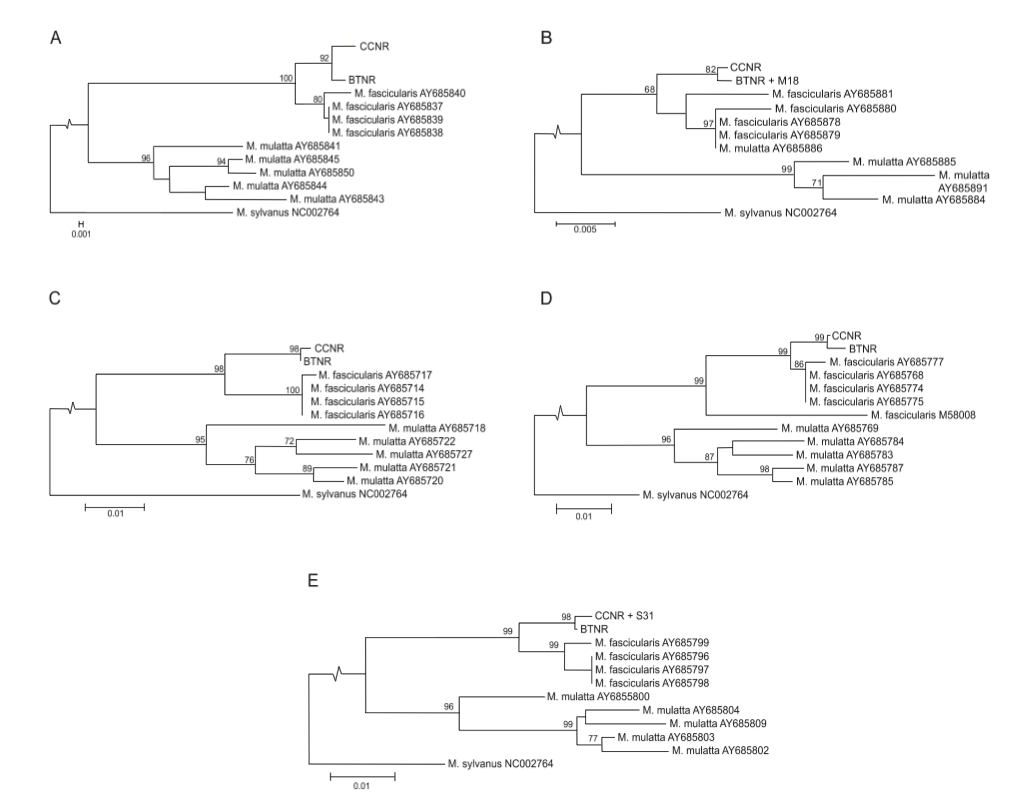
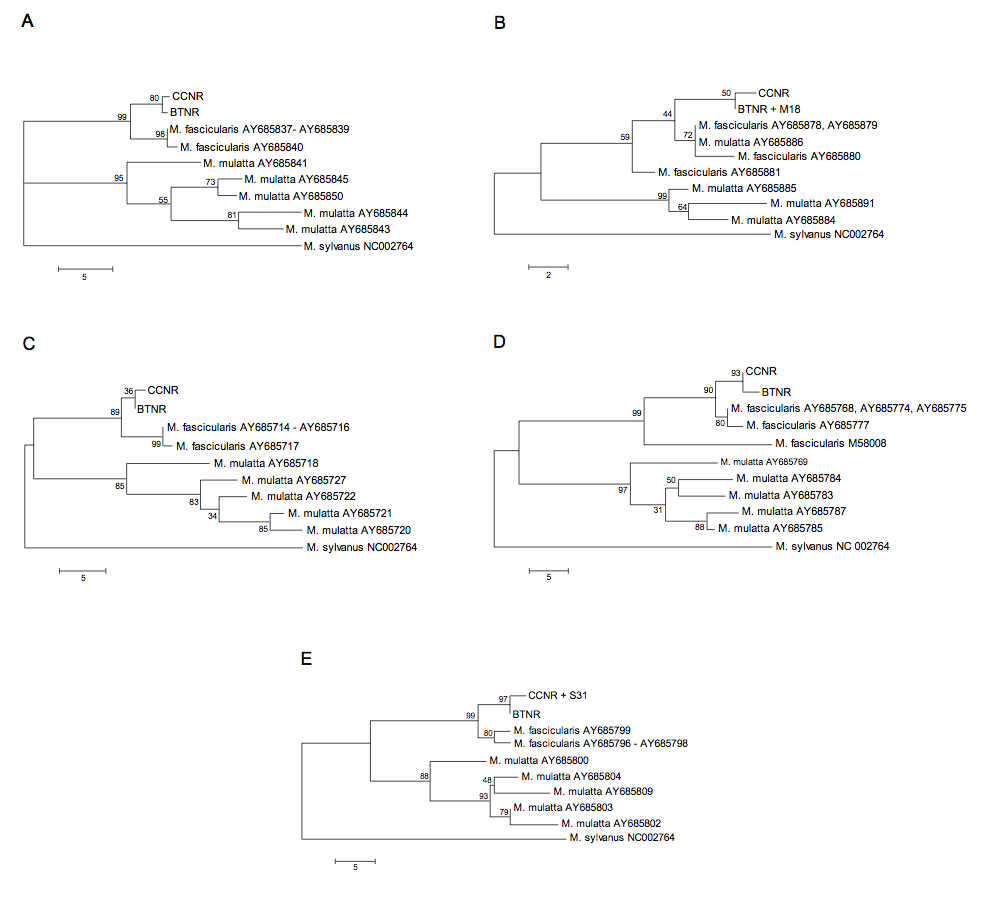
Maximum parsimony trees depicted for the respective five mitochondrial DNA fragments, A: ctyb; B: 12s rRNA; C: COI; D: COII and E: COIII. Bootstrap values indicated at the nodes. Values vary from 89-99% (ctyb, COI, COII, COIII) and 40% (12s rRNA), which indicates a relatively strong support for monophyletic grouping. Photo by Schillaci et al., 2011, permission pending.
8. Useful Links
Species-related
Long-tailed Macaque on Primate Info Net
Long-tailed Macaque on WildSingapore
Long-tailed Macaque on Ecology Asia
Burmese long-tailed Macaque on Project Sea Monkey Website and Facebook Page
Conflict Management
Why you should not feed monkeys on WildSingapore
How macaques and humans can live together in Singapore on WildSingapore
Activities
Monthly monkey walks by NParks and JGIS
9. References
[1] Zimmer, B, 2006. Makaku, Macaco, Macaque, Macaca..., Language Log. Retrieved from
http://itre.cis.upenn.edu/~myl/languagelog/archives/003458.html. Accessed on 13 November 2014.
[2] Tan, R, 2009. Long-tailed Macaque, Wild Singapore. Retrieved from http://www.wildsingapore.com/wildfacts/vertebrates/mammals/fascicularis.htm . Accessed on 6 November 2014.
[3] Fooden, J., 1995. Systematic Review of Southeast Asian Longtail Macaques, Macaca fascicularis (Raffles, [1821]). Fieldiana Zoology, 81: 1-3.
[4] Southwick, C. H & F.C. Cadigan, 1972. Population Studies of Malaysian Primates. Primates, 13: 1-18.
[5] Adrich-Blake, F. P. G, 1980. Long-Tailed Macaques. In Chivers, D. J (ed.), Malaysian Forest Primates. Springer Science+Business Media, New York. Pp. 147-166.
[6] Sussman, R. W & I. Tattersall, 1986. Distribution, Abundance, and Putative Ecological Strategy of Macaca fascicularis on the Island of Maritius, Southwestern Indian Ocean. Folia Primatology, 16: 28-43.
[7] Gumert, M.D., 2011. The common monkey of Southeast Asia: Long-tailed macaque populations, ethnophoresy, and their occurrence in human environments. In Gumert, M. D., Fuentes, A & Jones-Engel, L (eds), Monkeys on the Edge: Ecology and Management of Long-Tailed Macaques and their Interface with Humans. Cambridge University Press, United Kingdom. Pp. 3-44.
[8] Sha, J. C. M., M. D. Gumert, B. P. Y-H. Lee, A. Fuentes, S. Rajathurai, S. Chan & L. Jones-Engel, 2009. Status of the long-tailed macaque Macaca fascicularis in Singapore and implications for management. Biodiversity Conservation, 18: 2909-2926.
[9] Yeager, C. P, 1996. Feeding Ecology of the Long-Tailed Macaque (Macaca fascicularis) in Kalimantan Tengah, Indonesia. International Journal of Primatology, 17(1): 54-56.
[10] Sha, J. C. M & G. Hanya, 2013. Diet, Activity, Habitat Use, and Ranging of Two Neighboring Groups of Food‐Enhanced Long‐Tailed Macaques (Macaca fascicularis). American Journal of Primatology, 75: 581–592.
[11] Sussman, R. W & I. Tattersall, 1981. Behaviour and Ecology of Macaca fascicularis in Mauritius: A Preliminary Study. Folia Primatology, 22(2): 192-205.
[12] O’Leary, H & J. E. Fa, 1993. Effects of Tourists on Barbary Macaques at Gibraltar. Folia Primatology, 61: 77-91.
[13] Hambali, K. A. Ismail & B. M. Md-Zain, 2012. Daily Activity Budget of Long-tailed Macaques (Macaca fascicularis) in Kuala Selangor Nature Park. International Journal of Basic & Applied Sciences, 12(4): 47-50.
[14] Karimullah & S. Anuar, 2011. Social Organization and Mating System of Macaca fascicularis (Long Tailed Macaques). International Journal of Biology, 3(2): 23-31.
[15] Bernstein.I.S (1973). Principles of Primate Group Organization. In Chiarelli.A.B (Eds), Perspectives in Primate Biology (283-293). New York: Plenum Press.
[16] Berard, J. D, P. Nornberg, J. T. Epplen & J. Schmidtke, 1993. Male Ranke, Reproductive Behaviour, and Reproductive Success in Free-ranging Rhesus Macaques. Primates, 34(4): 481-489.
[17] Chadwick-Jones, J, 1998. Dominance and social relationships. Developing a Social Psychology of Monkeys and Apes. United Kingdom: Psychology Press.
[18] Hsu, M. J, C-C. Kao & G. Agoramoorthy, 2009. Interactions between Visitors and Formosan Macaques (Macaca cyclopis) at Shou-Shan Nature Park, Taiwan, American Journal of Primatology, 71: 214–222.
[19] Wong, C. L & I-H. Ni, 2000. Population Dynamics of the Feral Macaques in the Kowloon Hills of Hong Kong. American Journal of Primatology, 50: 53–66.
[20] Md-Zain, B. M, M. R. Tarmizi and M. Mohd-Zaki, 2011. In Gumert, M. D., Fuentes, A & Jones-Engel, L (eds), Monkeys on the Edge: Ecology and Management of Long-Tailed Macaques and their Interface with Humans. Cambridge University Press, United Kingdom. Pp. 101-113.
[21] Sha, J. C. M., M. D. Gumert, B. P. Y-H. Lee, L. Jones-Engel, S. Chan & A. Fuentes, 2009. Macaque– Human Interactions and the Societal Perceptions of Macaques in Singapore. American Journal of Primatology, 71:825–839.
[22] Klegarth, A, 2014. Personal communication via email.
[23] Jabbar, S, 2014. Personal communication.
[24] Fooden, J., 1995. Systematic Review of Southeast Asian Longtail Macaques, Macaca fascicularis (Raffles, [1821]). Fieldiana Zoology, 81: 1-3.
[25] Fooden, J., 2006. Comparative review of fascicularis-group species of macaques (Primates: Macaca) . Fieldiana: Zoology, 107: 1-43.
[26] Eudey, A. A., 2008. The Crab-Eating Macaque (Macaca fascicularis): Widespread and Rapidly Declining. Primate Conservation, 23(1): 129-130.
[27] Khew, C., 2014. Monkey see, monkey do as the guard says?, The Straits Times. Retrieved at http://news.asiaone.com/news/singapore/monkey-see-monkey-do-guard-says. Accessed on 6 November 2014
[28] Lucas, P. W, 1995. Long-tailed macaques. In Chung, C.S., Corlett, R.T., Wee, Y.C & Geh, S.Y (eds), Forest in the city: Bukit Timah Nature Reserve Singapore. reThe Gardens Bulletin, National Parks Board.
[29] Teo, R. C. H & S. Rajathurai, 1997. Mammals, reptiles and amphibians in the Nature Reserves of Singapore— diversity, abundance and distribution. In: Chan, L & Corlett, R. T (eds), Biodiversity in the Nature Reserves of Singapore. Proceedings of the Nature Reserves Survey Seminar Gardens, Bulletin Singapore, 49: 353–425.
[30] Agoramoorthy, G & M. Hsu, 2006. Population status of long-tailed macaques (Macaca fascicularis) in Singapore. Mammalia, 70, 300 pp.
[31] Tosi, J. A., J. C. Morales and D. J. Melnick, 2000. Comparison of Y Chromosomes and mtDNA Phylogenies Leads to Unique Inferences of Macaque Evolutionary History. Molecular Phylogenetics and Evolution, 17(2), 133-144.
[32] Ong, P & M. Richardson, 2008. Macaca fascicularis. The IUCN Red List of Threatened Species. Version 2014.2. Retrieved from www.iucnredlist.org. Accessed on 6 November 2014.
[33] Brandon-Jones, D., A. A. Eudey, T. Geissmann, C. P. Groes, D. J. Melnick, J. C. Morales, M. Shekelle & C-B. Stewart, 2004. Asian Primate Classification. International Journal of Primatology, 25(1): 155.
[34] Fooden, J., 1976. Provisional Classification and Key to Living Species of Macaques (Primates: Macaca). Folia Primatology, 25: 225-236.
[35] Fooden, J., 1982. Ecogeographic Segregation of Macaque Species. Primates, 23(4): 574-579.
[36] Deinard, A and D. G. Smith, 2001. Phylogenetic relationships among the macaques: evidence from the nuclear locus NRAMP1. Journal of Human Evolution, 41, 45-46.
[37] Tosi, A. J., J. C. Morales and D. J. Melnick, 2003. Paternal, Maternal, and Biparental Molecular Markers Provide Unique Windows onto the Evolutionary History of Macaque Monkeys. Evolution, 57(6), 1419-1435.
[38] Zhang, Y-P & L-M. Shi, 1993. Phylogenetic Relationships of Macaques as Inferred form Restriction Endonuclease Analysis of Mitochondrial DNA. Folia Primatology, 60: 7-17.
[39] Morales, J. C & D. J. Melnick, 1998. Phylogenetic relationships of the macaques (Cercopithecidae: Macaca), as revealed by high resolution restriction site mapping of mitochondrial ribosomal genes. Journal of Human Evolution, 34: 1-23.
[40] Tosi, A. J., J. C. Morales & D. J. Melnick, 2000. Comparison of Y Chromosome and mtDNA Phylogenies Leads to Unique Inferences of Macaque Evolutionary History. rMolecular Phylogenetics and Evolution, 17(2): 133-144.
[41] Tosi, A. J., J. C. Morales., D. J. Melnick, 2003. Paternal, Maternal, and Biparental Molecular Markers Provide Unqiue Windows onto tthe Evolutionary History of Macaque Monkeys. Evolution, 57(6): 1419-1435.
[42] Li, J., K. Han, J. Xing, H-S. Kim, J. Rogers, O. A. Ryder, T. Disotell, B. Yue, M. A. Batzer, 2009. Phylogeny of the macaques (Cercopithecidae: Macaca) based on Alu elements. Gene, 228: 242-249.
[43] Deinard, A and D. G. Smith, 2001. Phylogenetic relationships among the macaques: evidence from the nuclear locus NRAMP1. Journal of Human Evolution, 41, 45-59.
[44] Schillaci, M. A, S. Saravia, B. P. Y.-H. Lee and C. Matheson, 2011. Preliminary Report on Mitochondrial DNA Variation in Macaca fascicularis From Singapore. The Raffles Bulletin of Zoology, 59(1), 101-108.